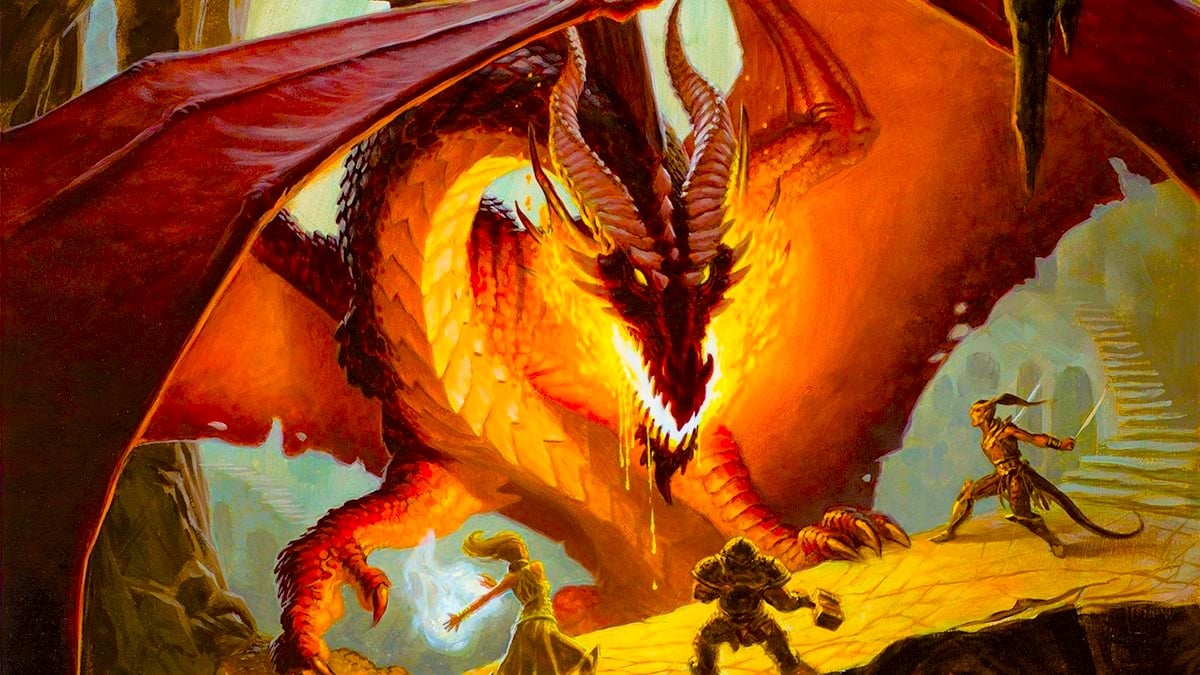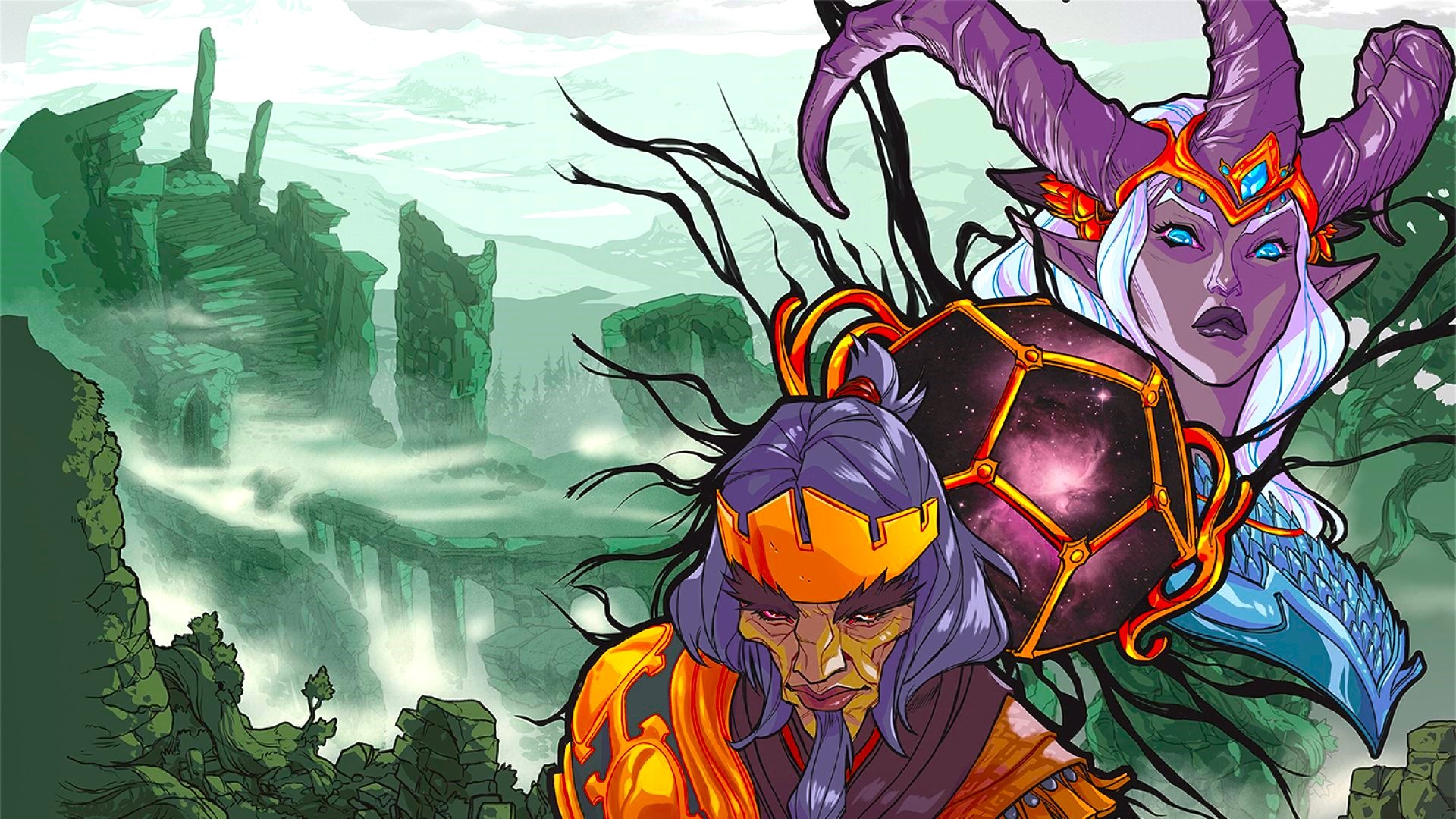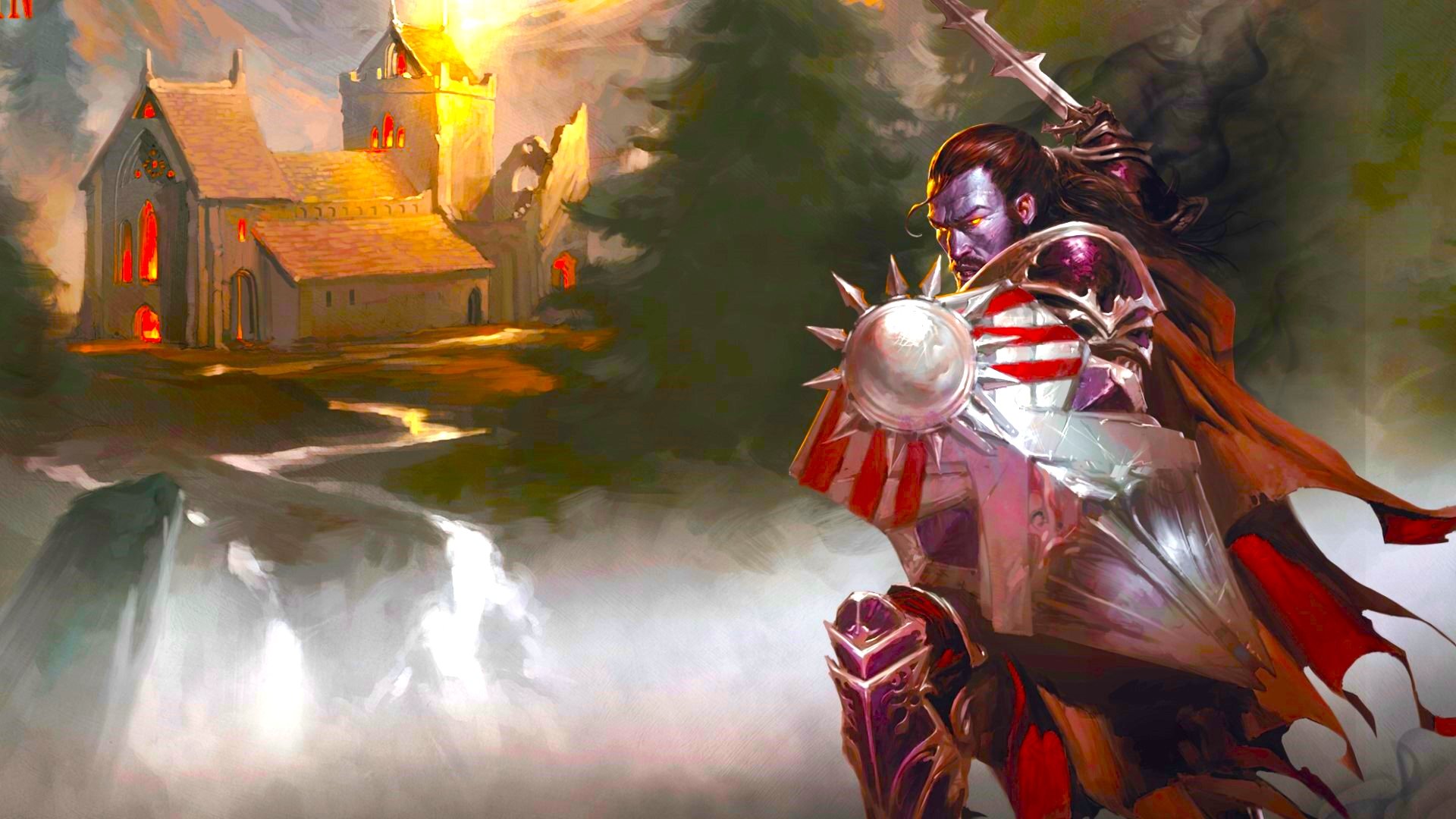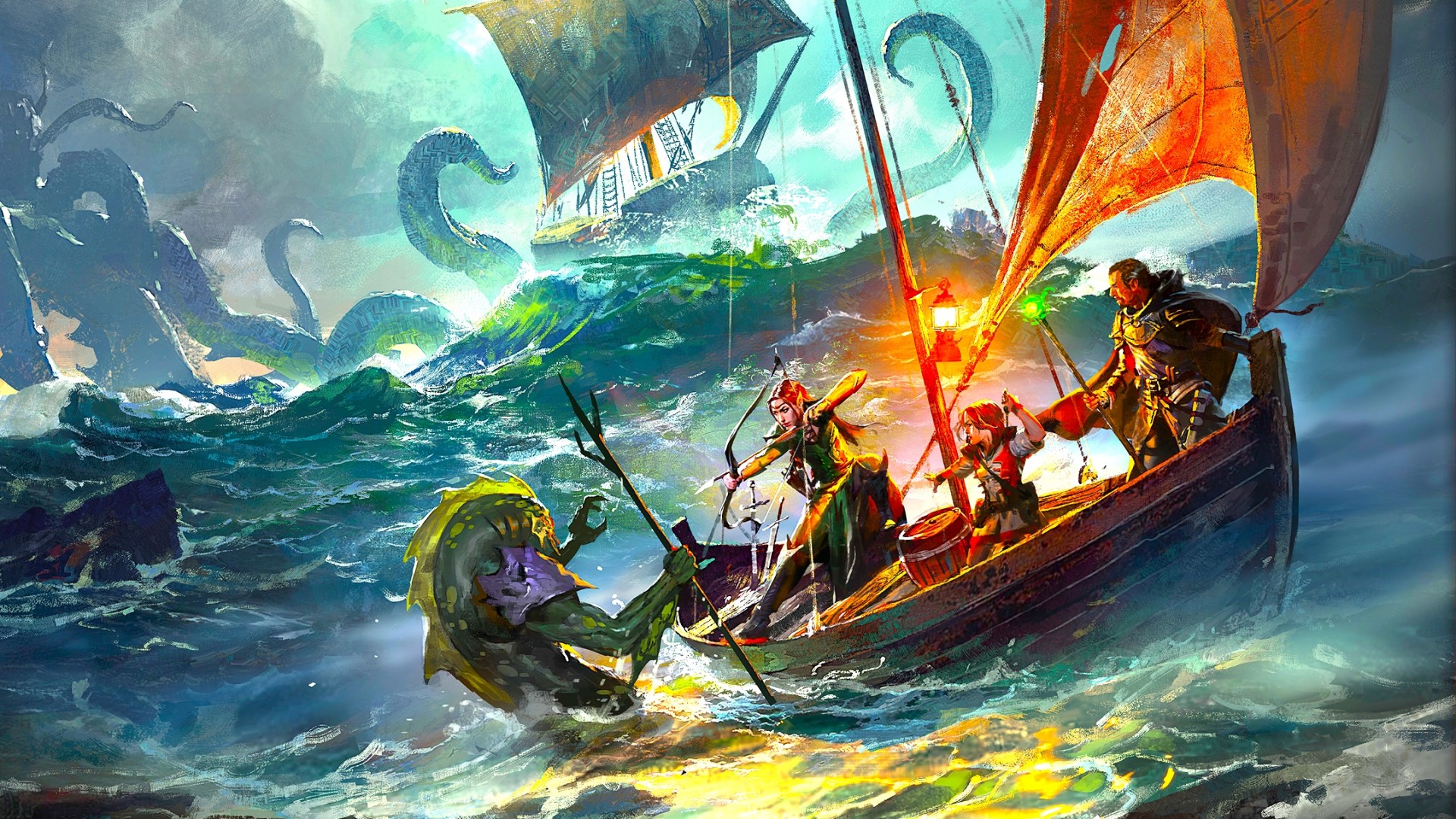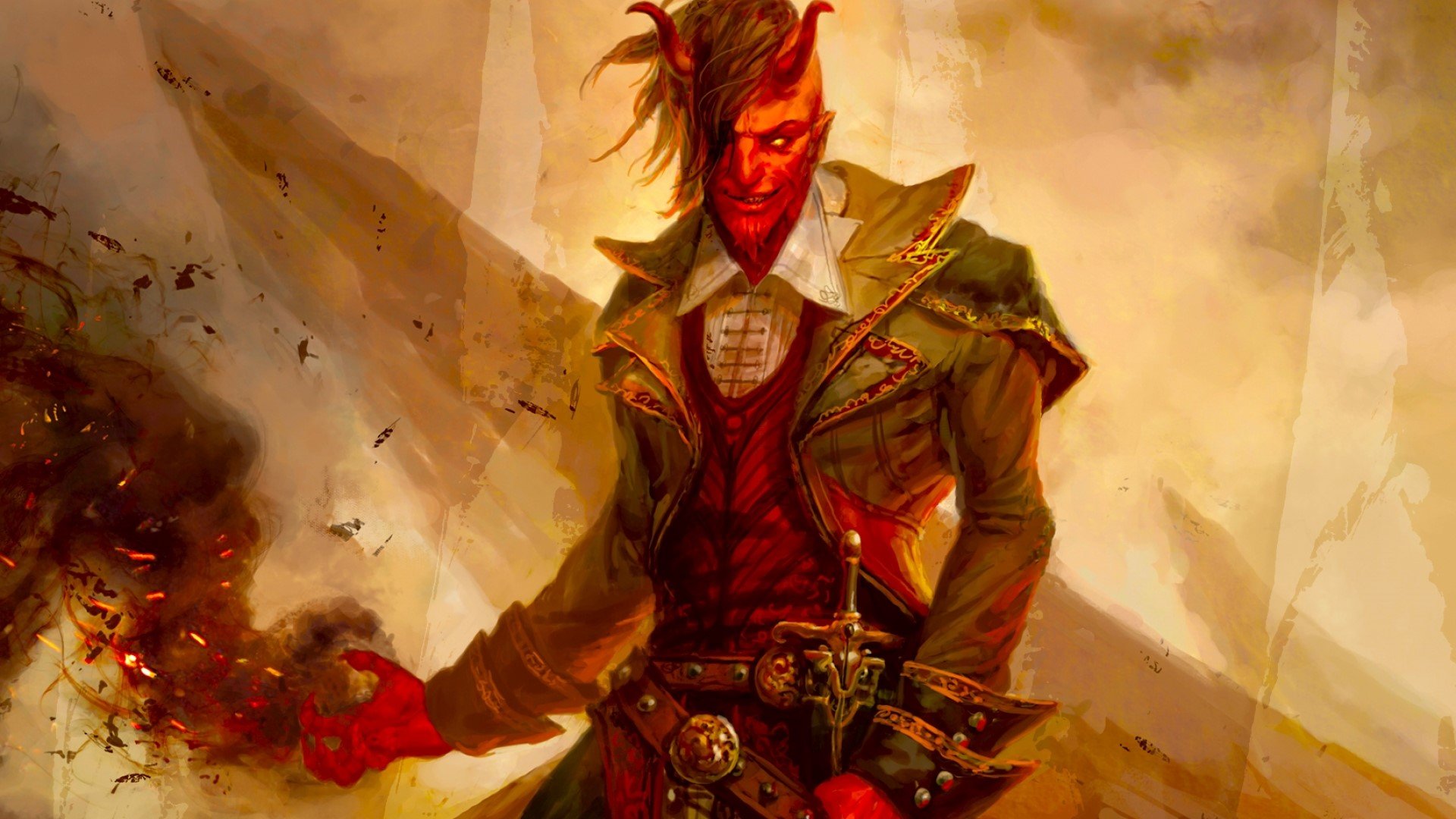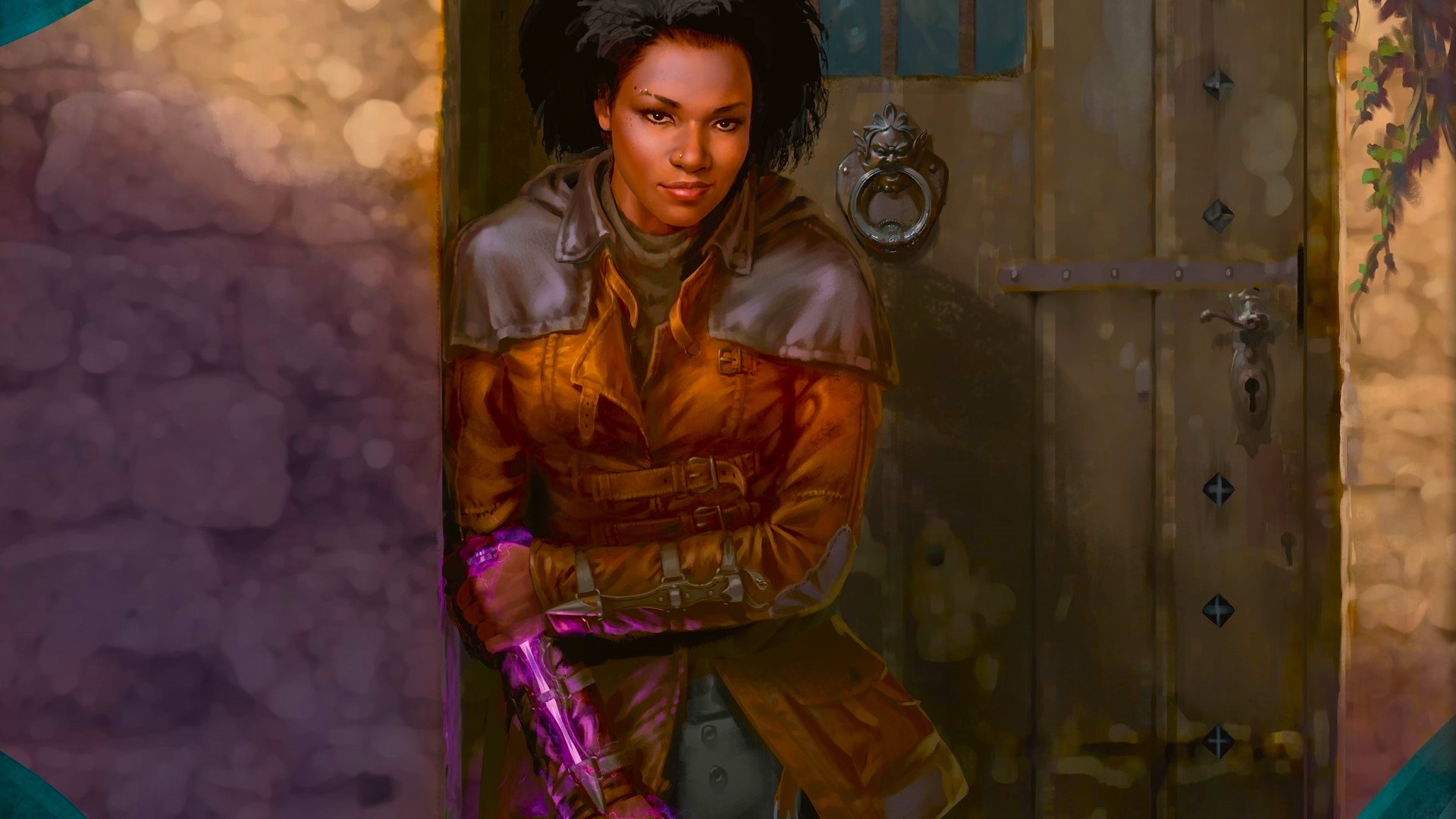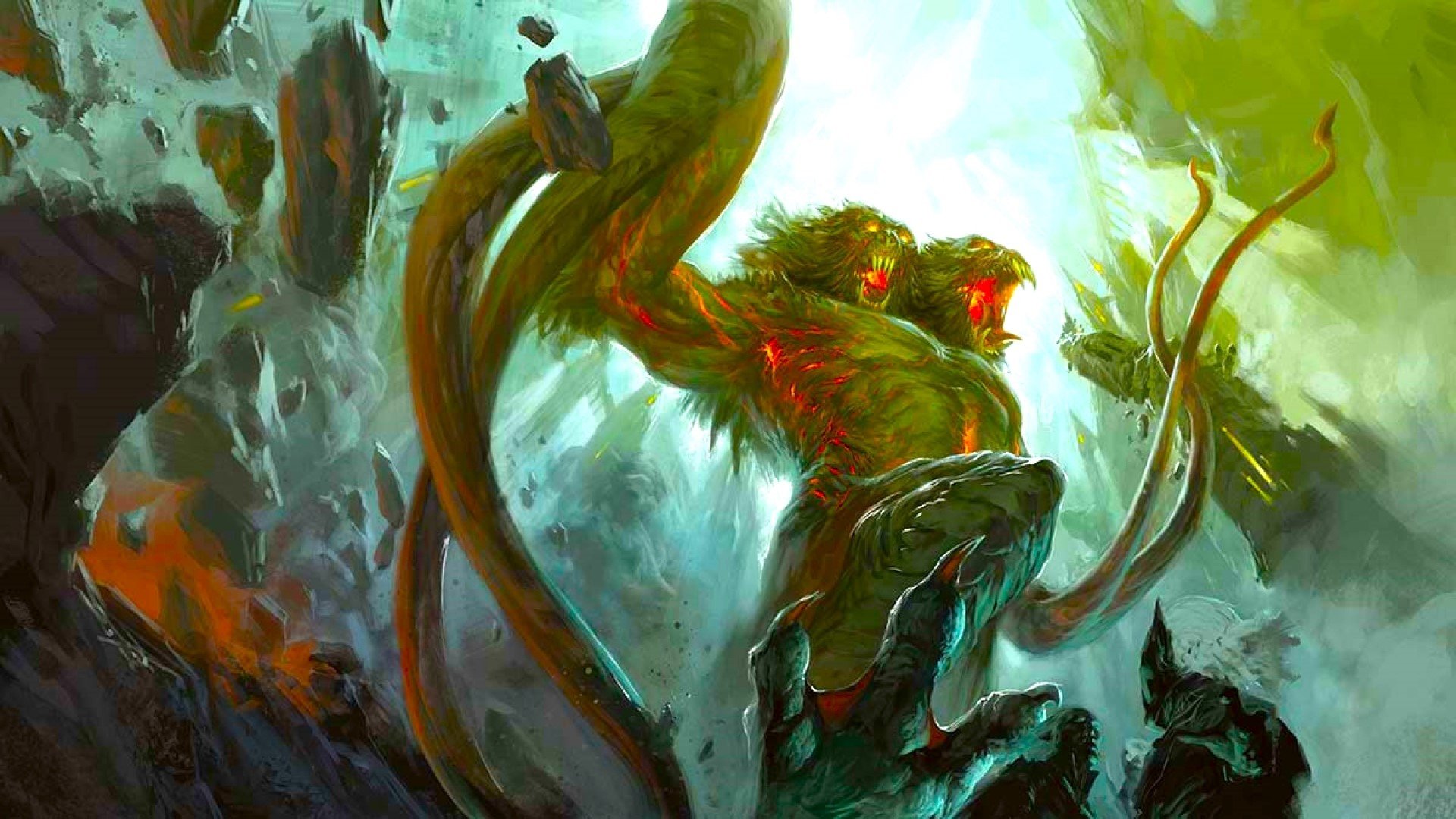If it’s darkness you’re after, you might want to consider trying out the DnD Blood Hunter 5E class. Here’s a potential character so edgy that it not only cuts you – it uses your wounds to cast powerful spells. The Blood Hunter is a dedicated warrior, prepared to sacrifice their own health to deal devastating damage to all things evil – while trying not to succumb to their own darkness.
Critical Role Dungeon Master Matt Mercer, creator of the DnD Blood Hunter 5E class, has said these haemoglobin hunters were inspired by The Witcher series. It’s no wonder, then, that they set you up for some seriously dark and broody roleplay.
Blood Hunters aren’t an official class that you can find in typical DnD books. However, they’re considered an unofficial class, meaning you can find everything you need to roleplay one on D&D Beyond – or, if you’d rather homebrew your own, you can use the Blood Hunter monster description in Explorer’s Guide to Wildemount. This guide is designed to make your entry into the world of hemocraft easy and (mostly) painless.
Here’s how to play a DnD 5E Blood Hunter:
Blood Hunter 5E stats
| Hit dice | 1d10 per level |
| HP at level up | 1d10 + Constitution modifier |
| Primary ability scores | Strength or Dexterity, then Intelligence or Constitution |
| Armour proficiency | Light armour, medium armour, shields |
| Weapon proficiency | Simple weapons, martial weapons |
| Tool proficiency | Alchemist’s supplies |
| Saving throws | Dexterity, Intelligence |
| Starting skill proficiencies | Three from: Acrobatics, Arcana, Athletics, History, Insight, Investigation, Religion, Survival |
| Starting equipment | 1 martial weapon or 2 simple weapons, light crossbow and 20 bolts, studded leather armour or scale mail armour, explorer’s pack, alchemist’s supplies |
When drawing up your Blood Hunter 5E stats, you should first decide whether you want to wield melee weapons, or whether you’d prefer archery or finesse weapons for your regular, non-magical attacks. If the former, then put Strength (STR) as your highest ability score; if the latter, then choose Dexterity (DEX) instead.
Next, we get to the one thing Blood Hunters are most famous for – hemocraft, their powerful blood-letting magic. Choose Intelligence (INT) as your second-highest stat if you want to create devastating blood curses, but choose Constitution (CON) instead if you’d rather beef up your hit points in preparation for all the wounds you’ll be self-inflicting.
Having some points in Wisdom (WIS) will be helpful for Perception and Survival checks, as Blood Hunters will often need to track down their next foe in their quest to defend the realm from darkness. Of course, how many points you have in WIS should be weighed up after you’ve nailed your Blood Hunter’s fighting style.
When it comes to choosing your lowest, ‘dump’ stat, Charisma (CHA) is the obvious choice. The secrets of hemocraft are closely guarded by the Blood Hunter orders, and many in the general populace are unsettled by Blood Hunters at the best of times – meaning they’re not exactly social butterflies.
Blood Hunter 5E class features
| Feature | Level |
| Hunter’s Bane | 1 |
| New blood curse | 1, 6, 10, 14, 18 |
| Blood Maledict | 1 |
| Fighting style | 2 |
| New crimson rite | 2, 7, 14 |
| Blood Hunter order features | 3, 7, 11, 15, 18 |
| Ability score improvement | 4, 8, 12, 16, 19 |
| Extra attack | 5 |
| Brand of Castigation | 6 |
| Grim Psychometry | 9 |
| Dark Augmentation | 10 |
| Brand of Tethering | 13 |
| Hardened Soul | 14 |
| Sanguine Mastery | 20 |
A first-level Blood Hunter has undergone the Hunter’s Bane ritual, which changes their blood and forever binds them to the darkness. In terms of rules, this means your Blood Hunter has advantage on Survival (WIS) checks from the get-go (so no need to panic if you haven’t got as many points in WIS as in STR and DEX).
Thanks to the Hunter’s Bane ritual, however, you’ll also sometimes need to make saving throws to resist the call of the darkness you channel – add eight to your proficiency bonus and Hemocraft modifier (INT or WIS) to do so.
This also means you can start using some (albeit limited) hemocraft magic straight away. At level one, you know one blood curse of your choice (more on each of these below). You can choose to amplify the power of a blood curse, but such power comes at a price.
The Blood Maledict feature requires you to take necrotic damage equal to one hemocraft die in order to perform the amplification. Low-level Blood Hunters must rest before using the feature again, but it can be used twice between rests from level six, three times from level 13, and four times from level 17.
As your character grows, you’ll also adopt a specific fighting style (archery, duelling, great weapon fighting or two-weapon fighting), and join a Blood Hunter order that gives you special perks (but more on these later).
You’ll also gain access to crimson rites, a form of hemocraft that infuses your weapon of choice – allowing it to deal fire, cold, lightning, necrotic, psychic, or thunder damage (the last three only being available from level 14). Crimson rites can be activated on the weapon you’re holding using a bonus action, but you have to roll your hemocraft die and take the result as necrotic damage as a trade-off.
Blood Hunters of sixth level and above can also use an active crimson rite to invoke the Brand of Castigation. When you damage a creature with a weapon using an activated crimson rite, your hemocraft can brand it with an arcane symbol – one that tells you the creature’s location as long as it’s on the same plane, and one that also deals psychic damage equal to your hemocraft modifier any time the creature harms you.
The Brand of Castigation will become the Brand of Tethering at level 13, which increases the psychic damage you deal to twice your hemocraft modifier. It also prevents creatures from taking the Dash action, and attempts to teleport away cause psychic damage or outright failure.
Grim Psychometry may sound like a dark and terrible Blood Hunter feature, but it simply refers to rolling with advantage on History (INT) checks that are to do with uncovering the history of an object that’s been touched by evil. While you earn this feature to boost your brainpower at level nine, level ten introduces Dark Augmentation to boost your physical resilience.
Your speed here increases by five feet, and you’ll get a bonus to STR, DEX, and CON saving throws equal to your hemocraft modifier. You’ll also earn advantage on saving throws against being charmed or frightened at the 14th level thanks to the feature Hardened Soul.
Of course, a truly expert Blood Hunter has honed their mind, body, and spirit in order to take on a world of darkness. So much has been sacrificed up to this point, that it only feels fair that the universe gives a little something back.
Because of this, level 20 Blood Hunters can activate Sanguine Mastery, which allows them to reroll a hemocraft die once per turn and use the roll of their choice. Additionally, if you score a critical hit using a weapon with an active crimson rite, you regain one use of the Blood Maledict feature that was already used up.
Blood Hunter 5E blood curses
Just as Wizards, Warlocks, and Sorcerers deal in spells, Blood Hunter 5E blood curses are the class’ magical bread and butter – though some are blocked off until you reach a high enough level or choose a certain Blood Hunter order. Many blood curses give you a bonus action, so whether you want to bind, charm, or poison an enemy, there’s something for you.
You’ll learn more blood curses as you level up, and you have the chance to swap your selection of blood curses every time you learn a new one. Below are each of the blood curses you can choose from, as well as how they can be amplified using the Blood Maledict feature:
Blood Curse of the Anxious: As a bonus action, you gain advantage on Intimidation (CHA) checks against the cursed creature. When amplified, the next WIS saving throw the cursed creature makes before the curse’s end has disadvantage.
Blood Curse of Binding: As a bonus action, you can attempt to bind a Large or smaller creature that’s within 30 feet of you. If it fails a STR saving throw, the creature’s speed is reduced to zero, and it can’t use reactions until the end of your next turn. When amplified, this curse lasts for one minute and can affect any size of creature – the creature can keep repeating saving throws at the end of its turns, however, ending the curse on a success.
Blood Curse of Bloated Agony: When cursing a creature within 30 feet of you as a bonus action, you cause its body to bloat horribly – giving it disadvantage on STR and DEX checks for the curse’s duration. If it makes more than one attack during its turn, it also takes 1d8 necrotic damage. The amplified version of this curse lasts for one minute, ending earlier if the creature passes a CON saving throw at the end of its turn.
Blood Curse of Exposure: When a creature within 30 feet takes damage from an attack or spell, you can use a reaction to weaken its resilience. This means, until the end of its next turn, it loses resistance to all damage types dealt by the triggering attack or spell (including for that triggering effect). When amplified, the target instead loses invulnerability to damage types of the triggering attack or spell – but it has resistance to them until the end of its next turn.
Blood Curse of the Eyeless: When a creature within 30 feet attacks, roll a hemocraft die as a reaction and subtract the number rolled from the creature’s attack roll. If the creature is immune to being blinded, it’s also immune to this curse. The amplified version applies the curse to all of the creature’s attack rolls until the end of its turn (but you roll separately for each affected attack).
Blood Curse of the Fallen Puppet: If a creature within 30 feet loses all its hit points, you can use a reaction to force it to immediately make one weapon attack against a target of your choice within its range. When amplified, you can also cause the creature to move up to half its speed, and you can add a bonus equal to your hemocraft modifier to its attack roll.
Blood Curse of the Marked: As a bonus action, you choose a creature within 30 feet. When you hit this creature using a weapon with an active crimson rite, roll an extra hemocraft die to determine extra damage. When amplified, the next attack roll you make against the target before the end of your turn has advantage.
Blood Curse of the Muddled Mind: As a bonus action, you can curse a creature within 30 feet that is concentrating on a spell or feature, giving it disadvantage on its next CON saving throw for maintaining concentration (before the end of your next turn). When amplified, the cursed creature has disadvantage on all CON saving throws for maintaining concentration until the end of your next turn.
Blood Curse of Corrosion (15th level, Order of the Mutant only): Your bonus action allows you to poison a creature within 30 feet of you, and the effects of the curse only dissipate when the creature succeeds on a CON saving throw at the end of its turn. When amplified, the creature takes 4d6 necrotic damage when it becomes cursed, and it keeps taking this damage every time it fails the saving throw.
Blood Curse of the Exorcist (15th level, Order of the Ghostslayer only): As a bonus action, choose a creature within 30 feet that is charmed, frightened, or under effects of possession, and remove the condition. When amplified, this curse, the creature that imposed the condition on the target takes 3d6 psychic damage and must succeed on a WIS saving throw or be stunned until the end of your next turn.
Blood Curse of the Howl (18th level, Order of the Lycan only): You howl a terrible howl as an action, and all creatures within 30 feet that can hear you become frightened on a failed WIS saving throw until the end of your next turn. Creatures who fail by five or more are also stunned, and the amplified version of the curse increases its range to 60 feet.
Blood Curse of the Soul Eater (18th level, Order of the Profane Soul only): When a non-construct, non-undead creature reaches zero hit points within 30 feet of you, you can use a reaction to offer their life energy to your patron, meaning you attack with advantage and have resistance to all damage until the end of your next turn. When amplified, you regain a used warlock spell slot, but you must complete a long rest to do this again.
Blood Hunter 5E orders
A character that wants to become a Blood Hunter can’t do so without the approval of one of the Blood Hunter 5E orders, secretive groups that guard the unique knowledge and abilities their kind possess. An individual must find and convince a Blood Hunter order to perform the Hunter’s Bane ritual, and even after that, they must earn their approval to fully join the order’s ranks. There are four Blood Hunter orders your character can pursue, each with distinct abilities they can grant you as you level up.
Order of the Ghostslayer
| Level | Ability |
| 3 | Rite of the Dawn, Curse Specialist |
| 7 | Aether Walk |
| 11 | Brand of Sundering |
| 15 | Blood Curse of the Exorcist |
| 18 | Rite Revival |
The Order of the Ghostslayer dedicates its members’ lives to the sanctity of death – and making sure that the dead stay dead. The Rite of the Dawn is a crimson rite designed specifically for this purpose: it deals additional radiant damage (and an extra hemocraft die to calculate this), gives you necrotic damage resistance, and it sheds 20 feet of bright, evil-banishing light. You’ll become a Curse Specialist who gets an additional use out of the Blood Maledict feature at this level, and you can target any creature with your powers, blood or no blood.
Seventh-level Blood Hunters in this order can also use Aether Walk to step between planes in pursuit of spirits, and the Brand of Sundering is an alteration of the Brand of Castigation that adds another die of hemocraft damage when determining the additional damage of your crimson rite – it also stops those pesky ghosts using their Incorporeal Movement. Finally, Rite Revival allows 18th-level Hunters to reabsorb a hit point that was fed to their weapon should their health reach zero.
Order of the Lycan
| Level | Ability |
| 3 | Heightened Senses, Hybrid Transformation |
| 7 | Stalker’s Prowess |
| 11 | Advanced Transformation |
| 15 | Brand of the Voracious |
| 18 | Hybrid Transformation Mastery |
As well as the Hunter’s Bane ritual, a Blood Hunter who pledges themselves to the Order of the Lycan can undergo another transformative ceremony: the Taming, a deliberate infliction of lycanthropy.
A third-level Hunter of this order has advantage on Perception (WIS) checks that rely on hearing or smell, and they can transform into a human-lycan-hybrid (based on their chosen beast form) for up to an hour at a time between rests, which gives them a range of bonuses in combat. You can transform more frequently as you level and gradually master the beast within.
Hybrid Transformation also comes with several benefits and drawbacks. Feral Might gives you advantage on STR checks and saving throws, as well as +1 to melee damage rolls (increasing to +2 at 11th level and +3 at 18th level). Resilient Hide provides resistance to bludgeoning, piercing, and slashing damage from attacks not made with a silvered weapon, and you get +1 to your AC while not wearing heavy armour.
Predatory Strikes means you can apply your Crimson Rite to unarmed strikes, and you can use DEX instead of STR for unarmed attack and damage rolls, dealing 16d bludgeoning or slashing damage in the process (this becomes 1d8 at 11th level). Finally, there’s Bloodlust. If you start a turn with less than half your hit point maximum, you must succeed on a DC 8 WIS saving throw or attack the nearest creature.
Your speed and jump distance increase at 7th level thanks to Stalker’s Prowess, and 15th-level Hunters can use the Brand of the Voracious, which allows advantage on attack rolls against the creature branded. Finally, the Blood Curse of the Howl is unlocked at level 18.
Order of the Mutant
| Level | Ability |
| 3 | Mutagencraft |
| 7 | Strange Metabolism |
| 11 | Brand of Axiom |
| 15 | Blood Curse of Corrosion |
| 18 | Exalted Mutation |
If alchemy and toxicology sound more up your alley than lycanthropy, consider the Order of the Mutant. These Hunters are making genetic modification happen in the Forgotten Realms, altering their biology to fare better in battle.
This begins with Mutagencraft, which allows you to consume a mutagen with certain side effects as a bonus action. You can then use an action to focus and flush a mutagen from your system when you want the effects to end. Your Blood Hunter can craft mutagens from formulas when finishing a rest, but their potency wears off over time if not used.
| Level | Mutagens and formulas |
| 3 | 1 mutagen created, 4 formulas known |
| 7 | 2 mutagens created, 5 formulas known |
| 11 | 2 mutagens created, 6 formulas known |
| 15 | 3 mutagens created, 7 formulas known |
| 18 | 3 mutagens created, 8 formulas known |
With all this internal chemistry, it’s no surprise that 7th-level Blood Hunters of this order gain immunity to poison damage and conditions. Strange Metabolism also allows you to ignore mutagen effects for one minute as a bonus action, once per long rest. Your affinity for alterations continues with Exalted Mutation, where you can switch out active mutagens at will using a bonus action.
For this order, the Brand of Castigation becomes the Brand of Axiom, which ends illusion or invisibility effects on the branded creature. Creatures that fail a WIS saving throw are stunned if they attempt to take on an alternative form.
The Blood Hunter 5E mutagens available are:
- Alluring – Advantage on CHA checks and disadvantaged initiative rolls
- Celerity – DEX and maximum DEX increase by 3 (or 4 at 11th level, and 5 at 18th). Disadvantage on WIS saving throws
- Conversant – Advantage on INT checks and disadvantage on WIS checks
- Deftness – Advantage on DEX checks and disadvantage on WIS checks
- Embers – Resistance to fire damage and vulnerability to cold damage
- Gelid – Resistance to cold damage and vulnerability to fire damage
- Impermeable – Resistance to piercing damage and vulnerability to slashing damage
- Mobility – Immune to being grappled and restrained (and paralysed at 11th level), but disadvantage on STR checks
- Nighteye – Darkvision of 60 feet is gained or increased and Perception (WIS) checks that rely on sight are disadvantaged in direct sunlight
- Percipient – Advantage on WIS checks, but disadvantage on CHA checks
- Potency – STR and maximum STR increase by 3 (or 4 at 11th level, and 5 at 18th). Disadvantage on DEX saving throws
- Rapidity – Speed increases by 10 feet (or 15 at 15th level), but disadvantage on INT checks
- Sagacity – INT and max INT increase by 3 (or 4 at 11th level, and 5 at 18th). Disadvantage on CHA saving throws
- Shielded – Resistance to slashing damage, and vulnerability to bludgeoning damage
- Unbreakable – Resistance to bludgeoning damage, and vulnerability to piercing damage
- Vermillion – Gain additional use of the Blood Maledict feature, but disadvantage on death saving throws
- Reconstruction (7th level) – If you have fewer than half your hit point maximum, you regain hit points equal to your proficiency bonus for one hour. Speed is reduced by ten feet during this time
- Aether (11th level) – Flying speed of 20 and disadvantaged STR and DEX checks for one hour
- Cruelty (11th level) – When attacking, make one extra weapon attack as a bonus action, but you have disadvantage on INT, WIS, and CHA saving throws
- Precision (11th level) – Weapon attacks score a critical hit on 19 or 20, but disadvantage on STR saving throws
Order of the Profane Soul
| Level | Ability |
| 3 | Otherworldly Patron, Pact Magic, Rite Focus |
| 7 | Mystic Frenzy, Revealed Arcana |
| 11 | Brand of the Sapping Scar |
| 15 | Unsealed Arcana |
| 18 | Blood Curse of the Soul Eater |
The Order of the Profane Soul takes its quest against evil to the next level, making pacts with lesser evils in order to tackle greater threats. Blood Hunters of this order have their own otherworldly patron. You can use The Archfey, the Fiend, or the Great Old One from the Player’s Handbook; The Undying from Sword Coast Adventurer’s Guide; The Celestial or the Hexblade from Xanthar’s Guide to Everything; The Fathomless or the Genie from Tasha’s Cauldron of Everything; or The Undead from Van Richten’s Guide to Ravenloft.
3rd-level Blood Hunters also get access to Pact Magic, meaning they learn two cantrips from the Warlock spell list (in the Player’s Handbook) and two first-level warlock spells. Another cantrip is unlocked at 10th-level, and you learn more spells at 7th,, 9th, 11th, 13th, 15th, 17th, and 19th level.
From 7th level you can learn second-level Warlock spells, third-level spells at level 13, and fourth-level spells at level 19. Use your hemocraft ability to cast spells, and your hemocraft modifier when setting the saving throw for a spell. You’ll also get an extra benefit, depending on your chosen patron, by using your weapon as a spellcasting focus thanks to Rite Focus. These can be anything from extra damage to gaining the power of flight temporarily.
| Patron | Rite Focus | Revealed Arcana |
| Archfey | Creatures damaged by crimson rite gain no benefit from cover or invisibility | Blur (7th), slow (15th) |
| Celestial | Use a Blood Maledict bonus action to heal a creature (hemocraft die + hemocraft modifier) | Lesser restoration (7th), revivify (15th) |
| Fathomless | A creature damaged by crimson rite has its speed reduced by 10 feet until the start of your next turn | Gust of wind (7th), lightning bolt (15th) |
| Fiend | Rolling 1 or 2 damage during Rite of Flame allows you to reroll the die and choose which roll to use | Scorching ray (7th), fireball (15th) |
| Genie | Use a Blood Maledict bonus action to gain flying (30 feet) for rounds equal to your hemocraft modifier | Phantasmal force (7th), protection from energy (15th) |
| Great Old One | Creatures of your choice within 10 feet are frightened when you score a critical hit | Detect thoughts (7th), haste (15th) |
| Hexblade | A creature targeted with a blood curse takes additional damage equal to your proficiency modifier when next hit | Branding smite (7th), blink (15th) |
| Undead | When taking necrotic damage, use a reaction to halve the damage | Blindness/deafness (7th), speak with dead (15th) |
| Undying | When a hostile creature reaches 0 hit points, you regain a number of hit points equal to one roll of your hemocraft die | Silence (7th), bestow curse (15th) |
Levelling up introduces you to Mystic Frenzy, which allows you to make a weapon attack as a bonus action when casting a cantrip. Both Revealed Arcana and Unsealed Arcana grant you patron-specific power, giving a unique spell in exchange for your patronage. The Brand of the Sapping Scar means that your Brand of Castigation also gives creatures disadvantage on saving throws against Warlock spells.
Best races for Blood Hunter 5E
Because there are several ways to build a strong Blood Hunter, there are plenty of D&D races that’ll fit the bill depending on what you’re after. If you’re planning to rely on your STR and CON, you’ll want to go with beefier races like Mountain Dwarves, Half Orcs, or Goliaths. Half Orcs and Goliaths both get +2 STR and +1 CON, while Mountain Dwarves have +2 for both stats. The Half Orcs’ Relentless Endurance, which allows them to drop to one hit point instead of zero, may come in handy when you’re sacrificing your own HP for hemocraft.
If you’d prefer to design your Blood Hunter around Dexterity and Intelligence, High Elves get +1 INT along with the standard elven +2 to DEX. A Stout Halfling has +1 to CON along with the standard +2 DEX, so this could be the race to go for if you want to focus on dextrous fighting without sacrificing that chunky CON. Similarly, the Genasi get a natural +2 to CON, with Air Genasi able to boost their DEX slightly too.
Source: Wargamer





